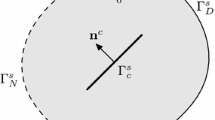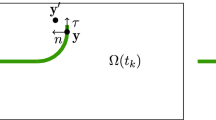Abstract
Previous work in modeling dynamic fracture has assumed the crack will propagate along predefined mesh lines (usually a straight line). In this paper we present a finite element model of mixed-mode dynamic crack propagation in which this constraint is removed. Applying linear elasto-dynamic fracture mechanics concepts, discrete cracks are allowed to propagate through the mesh in arbitrary directions. The fracture criteria used for propagation and the algorithms used for remeshing are described in detail. Important features of the implementation are the use of triangular elements with quadratic shape functions, explicit time integration, and interactive computer graphics. These combine to make the approach robust and applicable to a broad range of problems.
Example analyses of straight and curving crack problems are presented. Verification problems include a stationary crack under dynamic loading and a propagating crack in an infinite body. Comparisons with experimental data are made for curving propagation in a cracked plate under biaxial loading.
Similar content being viewed by others
References
Achenbach, J. D.; Bazant, Z. P. (1975): Elastodynamic near-tip stress and displacement fields for rapidly propagating cracks in orthotropic materials. J. Appl. Mech. 18/1, 1–22
Atluri, S. N.; Nishioka, T. N. (1985): Numerical studies in dynamic fracture mechanics. Int. J. Fracture 27, 245–261
Barsoum, R. S. (1977): Triangular quarter-point elements as elastic and perfectly-plastic crack tip elements. Int. J. Num. Meth. for Eng. 9, 495–507
Bathe, K.-J. (1982): Finite element procedures in engineering analysis. New Jersey: Prentice-Hall
Belytschko, T.; Hughes, T. R. (eds.) (1983): Computational methods for transient analysis. Amsterdam: North-Holland
Broberg, K. B. (1951): The moving griffith crack. Phil. Mag. 42, 739–750
Chen, Y. M.; Wilkins, M. L. (1977): Numerical analysis of dynamic Crack Problems. Elastodynamic crack problems. Leyden: Noordhoff
Dadkhah, M. S. (1984): Dynamic fracture under the influence of biaxial state of stress. Master's Thesis, Mech. Eng., University of Washington
Freund, L. B. (1972a): Crack propagation in an elastic solid subjected to general loading-I. Constant rate of extension. J. Mech. Phys. Solids 20, 129–140
Freund, L. B. (1972b): Crack propagation in an elastic solid subjected to general loading-II. Non-uniform rate of extension. J. Mech. Phys. Solids 20, 141–152
Freund, L. B. (1973): Crack propagation in an elastic solid subjected to general loading-III. Stress wave loading. J. Mech. Phys. Solids 21, 47–61
Freund, L. B. (1974): Crack propagation in an elastic solid subjected to general loading-III. Stress wave loading. J. Mech. Phys. Solids 22, 137–146
Freund, L. B.; Clifton, R. J. (1974): On the uniqueness of plane elastodynamic solutions for running cracks. J. Elasticity 4 293–299
Hawong, J. S.; Kobayashi, M. S.; Dadkhah, M. S.; Kang, S. J.; Ramulu, M.: Dynamic crack curving and branching under biaxial loading. Office of Naval Res., Tech. Rpt. No. UWA/DME/Tr-85/50
Henshell, R. D.; Shaw, K. G. (1975): Crack tip finite elements are unnecessary. Int. J. Numer. Meth. in Eng. 12, 93–99
Jung, J.; Ahmad, J.; Kanninen, M. F.; Popelar, C. H. (1981): Finite element analysis of dynamic crack propagation. Failure prevention and reliability, Proc. of the design engineering technical conference sponsored by the reliability stress analysis and failure prevention committee, the design engineering division of ASME, Hartford, Conn.
Key, S. W.; Beisinger, Z. E.; Krieg, R. D. (1978): Hondo II — A finite element computer program for the large deformation dynamic response of axisymmetric solids. SAND78–0422, Sandia National Laboratories, Alburquerque, NM.
Kobayashi, A. S.; Emery, A. S.; Mall, S. (1976): Dynamic-finite-element and dynamic-photoelastic analyses of two fracturing homalite-100 plates. Exper. Mech. 16/9, 321–328
Koh, H. M.; Haber, R. B. (1986): A mixed Eulerian-Lagrangian model for the analysis of dynamic fracture. UILU-ENG86–2003, University of Illinois, Urbana, Ill.
Metcalf, J. T.; Kobayashi, T. (1986): Comparison of crack behavior in homalite 100 and araldite B. Crack arrest methodology and applications, ASTM STP 711, Hahn, G. T.; Kanninen, M. F. (eds.), Amer. Soc. of Testing and Materials, 128–145
Nilsson, F. (1972): Dynamic stress-intensity factors for finite strip problems. Int. J. Fracture Mechanic 8/4, 403–411
Nishioka, T.; Atluri, S. N. (1980a): Numerical modeling of dynamic crack propagation in finite bodies, by moving singular elements-part 1: Formulation. J. Appl. Mech. 47, 570–576
Nishioka, T.; Atluri, S. N. (1986b): Numerical modeling of dynamic crack propagation in finite bodies by moving singular elements — part 2: Results. J. Appl. Mech. 47, 577–582
Nishioka, T.; Atluri, S. N. (1983): Path-independent integrals, energy release rates and general solutions of near-tip fields in mixed-mode dynamic fracture mechanics. Eng. Frac. Mech. 18/1, 1–22
Radok, J. R. M. (1956): On the solution of problems of dynamic plane elasticity. Q. Appl. Mathem. 14, 289–298
Rosakis, A. J.; Duffy, J.; Freund, L. B. (1984): The determination of dynamic fracture toughness of AISI 4340 steel by the shadow spot method. J. Mech. Phys. Solids 31/3, 251–260
Rossmanith, H.P. (1983): How mixed-mode crack propagation? A dynamic photoelastic study. J. Mech. Phys. Solids 31/3, 251–260
Sih, G. C.; Chen, E. P. (1977): Cracks moving at constant velocity and acceleration. Elastodynamic crack problems. Leyden: Noordhoff
Shaw, R. D.; Pitchen, R. G. (1978): Modifications to the Suhara-Fukuda method of network generation. Int. J. Numer. Meth. Eng. 12, 93–99
Swenson, D. V. (1986): Derivation of the near-tip stress and displacement fields for constant velocity crack without using complex functions. Tech. note in Eng. Fract. Mech. 18/1, 1–22
Swenson, D.V. (1985): Modeling mixed-mode dynamic crack propagation using finite elements. Dept. Struct. Eng. Rpt. No. 85–10, Civil and Environmental Engineering, Cornell University, Ithaca, NY
Swenson, D. V. (1986): On using combined experimental/analysis to generate dynamic critical stress intensity data. Presented at 19th national symposium on fracture mechanics, June 30–July 2, San Antonio, Texas. ASTM STP (to be publ.)
Thau, S. A.; Lu Tsin-Ywei (1971): Transient stress intensity for a finite crack in an elastic solid caused by a dilatational wave. Int. J. Solids and Struct. 7, 731–750
Valliappan, S.; Marti, V. (1985): Automatic remeshing technique in quasi-static and dynamic crack propagation. Proc. of the NUMETA 1985 Conference, Swansea, January 7–11
Yoffe, E. H. (1951): The moving griffith crack. Philosophical Magazine 42, 739–750
Author information
Authors and Affiliations
Additional information
Communicated by S. N. Atluri April 3, 1987
Rights and permissions
About this article
Cite this article
Swenson, D.V., Ingraffea, A.R. Modeling mixed-mode dynamic crack propagation nsing finite elements: Theory and applications. Computational Mechanics 3, 381–397 (1988). https://doi.org/10.1007/BF00301139
Issue Date:
DOI: https://doi.org/10.1007/BF00301139




